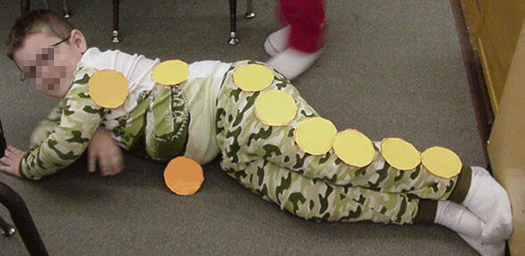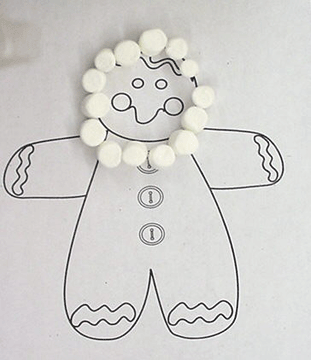|
Measurement

Use nonstandard measuring instruments and
make length comparisons regarding shorter, longer, or the same as. |

A
block is three pancakes long. How many pancakes long is the boy? |
|


|

|
|

How
many blocks will it take to balance everyday objects such as
scissors or crayons? This activity is from the book, Science Through
The Alphabet, by Sue Kerr. You can e-mail the author directly at
kerrific@charter.net
if you want to purchase her books. |

Laminate and hang up a string of die cut pumpkins (or pumpkins from
a tablet). Have each student stand
next to the pumpkins. A friend helps them measure themselves. A
photo could also be taken.) Students fill in a paper that says,
_______ is ____ pumpkins tall! Make this into a class book
entitled, How Tall is Mrs. _________s Class?
(Adapted from Mrs. Polh.meyer's site.)
|
|

We had to guess
which one of these worms is actually an "inchworm"---that is, which
one is really one inch long. After coloring our choice, we opened
the bottom of the paper and found the real inchworm. Then we used
inchworms to measure some common objects.
|
 |
|

|
We rolled clay
into snakes to compare the lengths.
Then we put the
snakes in order from shortest to longest. |
|
Footprints
Trace each child's
footprint and have them cut it out. Compare the sizes of the
footprints. Then sequence them by size.

|

|
|
 |

Then measure each
footprint with unifix cubes. Glue each one on a paper with these words:
_____________'s foot is
____ cubes long.
Combine these to make a
class book. |
|

Use marshmallows or other small candy to
measure the circumference of pictures.
|
Paper Clip or
Bean Non-Standard Measuring Device
Cut a strip of
packing tape place it sticky side up on a table. Lay either 10 paper
clips or lima beans in the middle of the tape. Fold sides of tape
over the clips or beans. Cut off the extra tape at the ends. Use a
sharpie to write the numbers 1-10 over the clips or beans. Use the
device to measure the length of different objects in the room.
|
|

We
are learning about measurement. Each child took off their shoe and
then had to find one thing in the room that was shorter than her
shoe and one thing that was longer.
|

These
students found the shorter and longer items very quickly.
|
|

We used clay to make one snake the same length as a crayon and then
a shorter and a longer snake.
|
|
|
This
idea was posted by Libby on Kinderkorner:
Take
those silly wind up toys that waddle and walk (very cheap--a dozen
for $7). Tape down 2 rows of unifix cubes as a track, making a lane
down the middle for the wind up toy to stay in as it travels.
Wind
up the toy, put it in the lane/track and measure how far it goes! (I
always put a standard on how many twists of the wind up toy they
get, and this is labeled on the graph we make.) When they get their
best distance, they get that many cubes and start making a class
graph. So if their toy went 8 unifix cubes in distance on the
windup, then they take 8 unifix cubes and put it in their graphing
spot.
This could be done as a center activity. It needs lots of modeling
first--like how to wind up, how to count the wind ups, how to make
the transfer from the distance count to the number of unifix cubes
to use, how to place the toy at the beginning point and how any
deviance from these standards ruins the validity of our study!!!
Then by Friday, you have a super graph! |